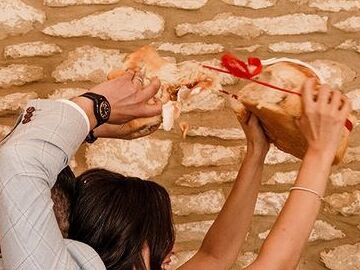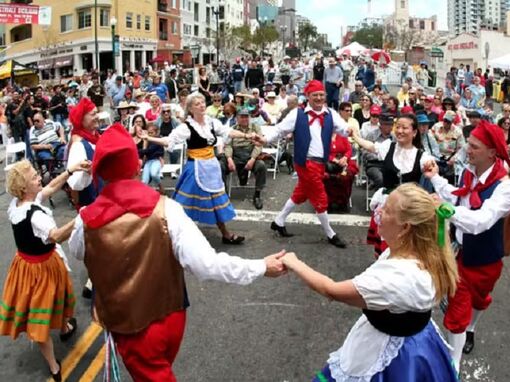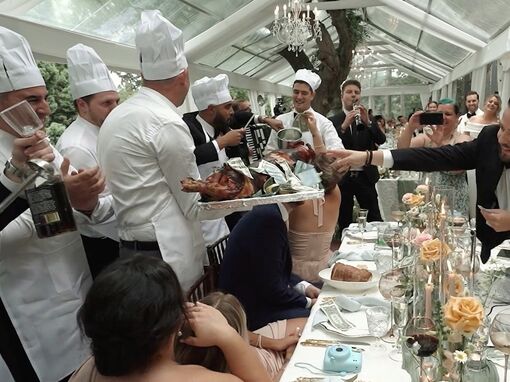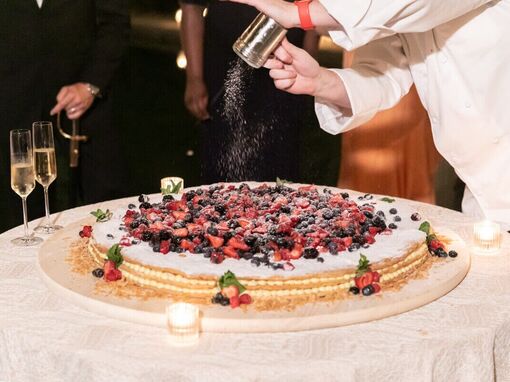Please RSVP before June 6th, 2025

Chantelle & Jordan
Please RSVP before June 6th, 2025
Chantelle & Jordan
Our Cultures Collide
Jordan and Chantelle are blessed to come from backgrounds rich in tradition and those values instilled upon them through their family and friends. Their wedding will celebrate Jordan's Macedonian background as well as Chantelle's Italian and South African culture with some of their favourite traditions. As these cultures collide and are united in marriage, they are happy to share these traditions and their origin stories below!
Kicking over a Glass of Wine
In Macedonian and Italian folk culture, before the ceremony the grooms family will come to get Chantelle as a gesture to bring her from her family into theirs. Baba, Jordan's grandmother, will provide 3 pieces of bread for Chantelle to throw in front of her, to the left and to the right. The bride will then be presented a glass of wine or water outside the front door. Chantelle will kick over the glass to symbolize a new life together in marriage that flows through all obstacles as smoothly as water. The spilling of red wine is also a positive omen and symbol of good luck and fortune.
The Breaking of the Bread

The breaking of the bread is a fun and humorous tradition involving the bride, the groom and a loaf of bread called the Koluk. The Koluk is round like a wedding band to symbolize eternity, no beginning and no end.
The Godfather will take the bread and do the traditional dance where family is invited to join in. Once the dance is over, the Koluk is presented to the Bride and Groom in loving competition. Chantelle and Jordan will each grab the bread with both hands and at the signal, vie to break off the bigger piece. The outcome will symbolize who is the "head of the household" and is a playful yet profound representation of shared responsibilities and the merger of their lives. Although naturally, the Bride is often well coached by the women in the family ;)
La Tarantella: The Italian Wedding Dance

La Tarantella is a joyous, traditional Italian folk dance rooted in Southern Italy, particularly in regions like Apulia, Calabria, and Sicily. Danced at Italian wedding receptions, typically immediately after the first course (Antipasti) as a symbol of joy, goodluck and the exciting beginning of a new life for the bride and groom.
The name “Tarantella” is derived from the spider, “tarantula,” whose bite was said to cause a hysterical condition known as tarantism. This dance is performed by the couples family and friends joining to form a circle around the bride and groom with quick tempo and movements to keep with the tempo of the music and symbolize a method to cure this condition.
The dance can include tambourines, noise makers or shakers and is seen as a way to bring the families together and bless the newlyweds with happiness, good health and prosperity.
The Macedonian Pig Dance

The Macedonian "Pig Dance" is a vibrant and deeply embedded tradition within the fabric of Macedonian wedding culture. This dance, involves a comical imitation of a pig’s movements in good humour and celebration, with male relatives presenting each table with a real roasted pig. This symbolizes abundance, fertility along with prosperity, representing the couple's hope for a future filled with joy, wealth, and happiness. The heads of the family taste the pig and will determine it's not seasoned enough! They proceed to "season" the pig by throwing money on it. The Pig Bearer and best man decides when he is happy with the "seasoning" and then the feast is served to the guests.
Millefoglie - Italian Wedding Cake

The cutting of the cake symbolizes mutual support and care, as the bride and groom unite their hands. The millefoglie is a traditional Italian wedding cake that symbolizes love, celebration, and joy. The cake's name translates to "a thousand leaves" and refers to its layers of puff pastry and cream. The cut from the bottom layer also symbolizes the longevity and continuity of Chantelle and Jordan's love story.